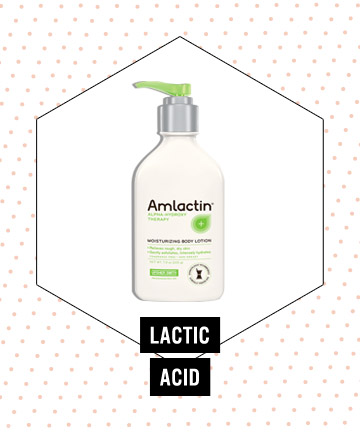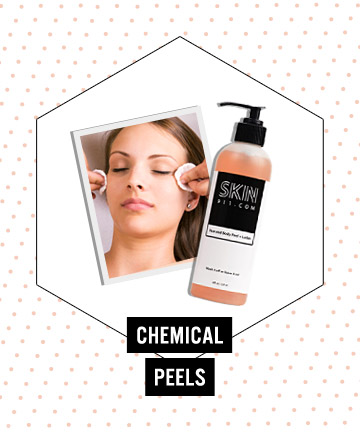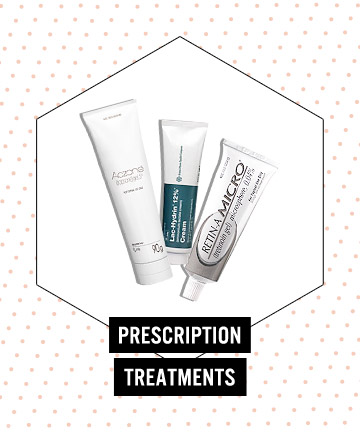What It Is: Lactic acid is a mild chemical exfoliator, which dissolves the keratin that makes up those pesky KP bumps from the inside out. The most-recommended OTC lactic acid treatment is AmLactin Moisturizing Body Lotion, $14.99
Who Should Use It: Since the molecules in lactic acid don't penetrate the skin as deeply as other chemical exfoliators, these treatments are excellent for sensitive or breakout-prone skin. They're also recommended for pregnant women, who want to avoid salicylic acid-based products.
Pro Tip: If you have irritation-prone skin, but AmLactin isn't doing the trick, skip to a prescription-strength lactic acid medication.
Who Should Use It: Since the molecules in lactic acid don't penetrate the skin as deeply as other chemical exfoliators, these treatments are excellent for sensitive or breakout-prone skin. They're also recommended for pregnant women, who want to avoid salicylic acid-based products.
Pro Tip: If you have irritation-prone skin, but AmLactin isn't doing the trick, skip to a prescription-strength lactic acid medication.
What It Is: Salicylic acid (SA) is a mainstay acne treatment for its ability to exfoliate and turn over dead cells quickly. The skin that forms a KP bump is similar to a pimple (albeit thicker); thus, SA-based creams and cleansers are effective and widely used for treating KP. (Try CeraVe SA Renewing Lotion, $14.99).
Who Should Use It: Those who experience both KP and acne can especially benefit from SA treatments. They're also worth trying if alpha hydroxy acids, such as lactic and glycolic acids, don't work for you.
Who Should Use It: Those who experience both KP and acne can especially benefit from SA treatments. They're also worth trying if alpha hydroxy acids, such as lactic and glycolic acids, don't work for you.
What It Is: "Glycolic acid is the best and most effective for KP, in my experience," says Schultz. This alpha hydroxy acid exfoliates more deeply than lactic acid. "But not all glycolic acids are created equal," Schultz adds. "There's a huge range of concentrations." For facial KP, Kazin recommends starting with cleansers and creams with a concentration of no more than five percent. For the body, a 10 percent lotion used twice daily tends to show noticeable improvement within three weeks. Most OTC glycolic acid treatments go up to 20 percent. (Try BeautyRx Daily Exfoliating Body Therapy Lotion, $50, or Glytone KP Kit, $68; for the face, choose Reviva Labs 5% Glycolic Acid Night/Day Cream, $25).
Who Should Use It: If you don't have easily irritated skin, and plain moisturizers aren't doing the trick, try glycolic acid next. If OTC glycolic products still aren't working, move onto a chemical peel.
Pro Tip: For best results, do not slather on gobs of product and expect to see next-day improvement. Use the product sparingly, but consistently, and you'll notice a change within weeks.
Who Should Use It: If you don't have easily irritated skin, and plain moisturizers aren't doing the trick, try glycolic acid next. If OTC glycolic products still aren't working, move onto a chemical peel.
Pro Tip: For best results, do not slather on gobs of product and expect to see next-day improvement. Use the product sparingly, but consistently, and you'll notice a change within weeks.
What It Is: When you go upwards of 10 percent salicylic or 20 percent glycolic acid, you're verging into peel territory. These are topical treatments applied in a dermatologist's office or salon, and usually consist of 20 to 30 percent salicylic or 40 percent glycolic acid. These high concentrations deeply exfoliate the skin, resulting in a much smoother, glowier surface. For an at-home version, try Skin 911 Face and Body Peel Plus Lotion, $85.
Who Should Use It: Those who haven't found OTC chemical exfoliators quite effective enough, and are looking for a more intensive treatment.
Pro Tip: It's important to remember that it takes 28 days for our bodies to reproduce the upper layer of skin. So if you don't see results from an OTC acid treatment overnight, don't skip directly to a peel. It takes a few weeks to see results.
Who Should Use It: Those who haven't found OTC chemical exfoliators quite effective enough, and are looking for a more intensive treatment.
Pro Tip: It's important to remember that it takes 28 days for our bodies to reproduce the upper layer of skin. So if you don't see results from an OTC acid treatment overnight, don't skip directly to a peel. It takes a few weeks to see results.
What It Is: Sometimes, OTC chemical treatments aren't potent enough to put those bothersome bumps to rest. Other times, the ingredients themselves don't work with your body. In such cases, KP sufferers might need a prescription treatment, such as a high-concentration lactic acid cream, urea medication or even acne treatment.
"One of my favorite prescription treatments is Aczone," says Jaliman. "It's a topical acne preparation made with dapsone, which is an anti-inflammatory, but works well for this condition." Jaliman says she has also used prescription retinoids, such as Renova and Retin-A, for some patients.
Who Should Use It: In severe cases or when OTC treatments aren't making a dent in your KP, consult a dermatologist about trying a prescription medication.
"One of my favorite prescription treatments is Aczone," says Jaliman. "It's a topical acne preparation made with dapsone, which is an anti-inflammatory, but works well for this condition." Jaliman says she has also used prescription retinoids, such as Renova and Retin-A, for some patients.
Who Should Use It: In severe cases or when OTC treatments aren't making a dent in your KP, consult a dermatologist about trying a prescription medication.









